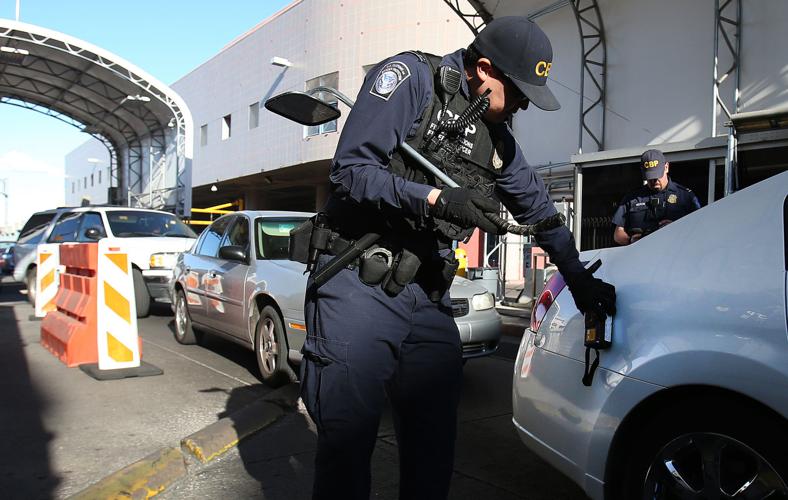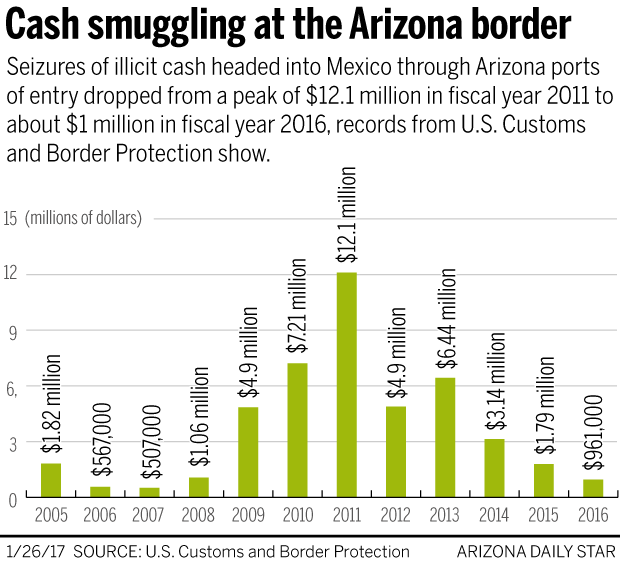Claudia Zuniga Aguilar’s daughter needed braces, so she decided to smuggle drug profits into Mexico for a cartel.
The Chandler resident was caught with $9,998 in her purse and wallet as she drove through the Nogales port of entry on March 15, U.S. District Court records show.
Zuniga Aguilar, 45, told customs officers she picked up the cash from a man in a Costco parking lot in Mesa. She was supposed to deliver it to an ice cream shop in Sonora in exchange for the down payment on her daughter’s orthodontia.
The seized money was just below the $10,000 cash reporting requirement, a tool used by U.S. Customs and Border Protection officers to prevent illicit cash smuggling. But as Zuniga Aguilar’s case shows, CBP officers also can seize any amount of money if they believe it’s the result of illegal activity.
CBP officers have seized $45 million in illicit currency at Arizona ports of entry since fiscal year 2005 and $211 million borderwide, according to agency statistics obtained by the Arizona Daily Star through a records request.
Those statistics also show cash seizures plummeted at ports of entry in Arizona and along the rest of the border in recent years. The reason for the decline is unclear, but experts point to smugglers using prepaid bank cards, trade-based money laundering and other tactics to evade detection.
Seizures rose borderwide from $8 million in 2005 to a peak of $37 million in 2009, a year in which the Laredo Field Office in Texas saw 78 percent of total seizures, or $29 million. But since then, cash seizures spread out more evenly along the border and the overall amount of seized cash dropped to $7 million in 2016.
Arizona ports saw a similar rise and fall, with seizures ranging from $500,000 to $1.82 million between 2005 and 2008. The next year, seizures rose to nearly $5 million and then peaked at $12.1 million in 2011.
In 2016, customs officers at Arizona ports seized $960,000, a 92 percent drop from the peak in 2011.
But experts say money is still getting across the border in immense amounts.
“We’re certain it’s a billion-dollar industry, and millions of dollars are going across the border, all of the time, weekly, monthly, we know this money is getting across,” said Erica Curry, a spokeswoman for the Drug Enforcement Administration’s Phoenix Field Division.
Authorities have begun to figure out how to police for the standard method of bulk cash smuggling in vehicles or strapped to bodies, but new methods mean new challenges, said Christopher Wilson, deputy director of the Mexico Institute at the Woodrow Wilson International Center for Scholars, a nonpartisan research center.
“There are so many different mechanisms that can move money across the border that it’s just very difficult,” he said.
Estimates of drug sales vary wildly, with the Justice Department saying in 2009 that Mexican and Colombian cartels sell anywhere from $18 billion to $39 billion worth of drugs in North America each year.
Although seizures by U.S. authorities plunged in recent years, busts by Mexican military and police in northern Sonora continue to yield multimillion-dollar seizures.
Last January, Mexican federal police seized $1 million — or $40,000 more than CBP officers in Arizona seized in fiscal year 2016 — from a truck on the highway between Santa Ana and Altar, Sonora, about 60 miles south of the border.
Mexican authorities seized a total of $26.5 million in a string of three incidents from November 2014 to July 2015 at the Sonoyta port of entry, across the border from Lukeville, according to news releases from the Mexican military reported by Mexican media.
In one incident, $13 million was stashed in empty fruit boxes inside a truck headed to Guadalajara. In another, $11.5 million was hidden among a load of strawberries bound for Mexico City. In the third incident, $2 million was tucked under a false floor of a truck.
On the other side of the border, CBP seized $1.8 million at Arizona ports from October 2014 to September 2015 and $13 million borderwide.
Feeding the cycle
When Rigoberto Mondaca, 66, tried to sneak through the southbound inspections at the pedestrian gates of a Nogales port of entry in July, CBP officers found $12,230 strapped to his lower back and hidden inside his shoes.
Mondaca admitted to officers he was trying to smuggle drug profits into Mexico, court records show. He was unemployed and he was offered $20 for every $1,000 he successfully smuggled into Mexico.
In a separate case, DEA agents watched Reynaldo Zamora pick up a package from an unidentified man at the Roy Laos Transit Center in Tucson in January 2015. When he arrived at the Nogales port the next day, CBP and DEA agents were waiting for him.
Authorities seized $29,175 from Wells Fargo envelopes that were taped around his ankles and hidden under his socks.
Smugglers like Mondaca and Zamora fit the profile of “contractors” who are paid to do a job, rather than smugglers who are “deeply involved” in cartel operations, Wilson said.
The illicit nature of drug trafficking means it is a cash-based market, Wilson said. “And that cash income has to get back to the people who owned and sold the drugs.”
The low-level smugglers move the money across the border and into the hands of the drug cartel or criminal organization, where the money fuels the trafficking cycle by paying for salaries, new product and bribes, Wilson said.
And when the money returns to Mexico, it perpetuates the cycle of violence that surrounds drug trafficking, Curry said.
“Not only in the United States, and definitely in Mexico, any time you have money, any time you have profits being transported, or stashed, or stored in a location on its way to the grand profiteer, I think it creates a vulnerability along that path for theft, robbery, home invasion, for violent crimes like assault or murder,” she said.
But before the cash can get to the border, it often has to make it to cities in Arizona or another border state.
Follow the money
State and federal court records regularly include civil cash seizures, in which cash is seized but the person is not charged with a crime.
In a November 2015 incident, Arizona state troopers working on Interstate 10 in Cochise County pulled over two truckers from Miami and found $517,000 concealed in rolled-up tarps.
Two months earlier, DEA agents at the Tucson International Airport found $24,800 in the inner lining of a purse and a sunglass case carried by a woman flying from New York.
Inspectors at the U.S. Postal Service processing center in Phoenix found $20,900 inside a vacuum-sealed bag hidden in a Priority Mail Express package in January 2015. The man who sent the package had sent six other packages to the same address in the previous four months, court records show.
In May, Pima County sheriff’s deputies made a traffic stop on South Craycroft Road near East 22nd Street that netted a man who used various bank accounts to launder at least $90,000 in marijuana sale proceeds from the East Coast, court records show.
Deputies also seized $7,000 stashed in the pants of the man’s accomplice, along with three debit cards that were not in his name.
The use of various bank accounts, known as funnel accounts, is a common method of money laundering, according to the U.S. Department of the Treasury. With funnel accounts, drug proceeds are deposited at branches in various states and then withdrawn at a single location, usually in a border state. From there, the cash is smuggled across the border or used to buy goods that are resold in Mexico.
New methods
After the Mexican government restricted the deposit of U.S. dollars in Mexican banks and currency exchange houses in 2010, the U.S. Treasury Department warned that money launderers were using funnel accounts and trade-based money laundering to move money across the border.
And just as smugglers use varied techniques to move cash to the border region, experts say the drop in cash seizures at the border since 2009 could be the result of new ways of moving money across the border, such as prepaid bank cards.
“The debit card, the gift cards, that’s a fairly new method of laundering money, but the end result is the same,” Curry said. “Any means they can use to clean up the money — trade-based, funnel accounts, peso exchanges, any of those — they will use to clean up money.”
Although bank cards are a relatively new smuggling tool, customs officers are “avidly” looking for them, said CBP spokeswoman Teresa Small.
If officers suspect someone is trying to smuggle bank cards loaded up with illicit drug profits, they are legally able to search for the cards, she said.
inspection authority
“Our border search authority allows us to be able to inspect anything,” Small said.
Through interviews and inspections of wallets and baggage, “we’re able to get a good sense if someone is trying to evade the laws,” she said.
Trade-based money laundering is a bit more convoluted than most other methods, Wilson said.
“They buy something with that cash in the United States, a big piece of machinery, and then they sell it in Mexico,” Wilson said.
In those cases, legitimate companies might move the equipment across the border without realizing they’re involved in money laundering, he said.
Federal agents watched Dennis and Alfonso Brown Barrientos meet their father, Dennis Brown Lopez, in a Walmart parking in June 2015.
The brothers’ frequent border crossings through Douglas had tipped Homeland Security agents to possible smuggling activity.
The agents watched the brothers remove the rear panels of their father’s truck and stuff bundles of cash into the compartment. The brothers later told authorities a man in Tucson gave them a bag with the cash, as well as water and candy, earlier that day.
When they arrived at the port of entry an hour after leaving the Walmart parking lot, CBP officers searched their vehicles and recovered $99,990, court records show.
The brothers began smuggling currency five months earlier, usually $3,000 to $5,000 each time. After a few successes, they started smuggling $100,000 per trip. Alfonso said he was paid between $200 and $1,000 for each trip.
Using intelligence, such as red flags raised by license plates, is the best way to stop cash smuggling, Wilson said.
“You can’t put a dent in this issue by sort of just in broad strokes trying to increase border security,” Wilson said. “It needs to be much more targeted than that, and to be more targeted we need better intelligence generation, better intelligence collection and processing.”
Increasing random trunk searches would place a strain on legitimate southbound traffic and commerce, Wilson said, noting ports of entry were designed primarily for inspections of northbound traffic, rather than traffic into Mexico.
Dogs frequently are used to catch drug and people smugglers at ports of entry, and CBP also uses dogs “as needed” to bust cash smugglers, Small said. But in most cases, officers’ training is enough to find hidden cash.
After catching a smuggler, one of the most difficult tasks can be making criminal charges stick, Curry said. “It’s not illegal to sell a car; it is not illegal to buy a car,” she said. “We have to prove that the money they’re using came from the illegitimate sale of narcotics in the United States.”
Another challenge is the international scope of the crimes, Curry said.
“The DEA can’t just reach into Mexico and begin investigating organizations in Mexico,” Curry said.
As long as trafficking organizations are based in Mexico, she said, “we really have to rely on cross-border cooperation to stem the flow of drugs and money.”








